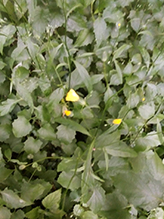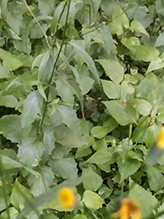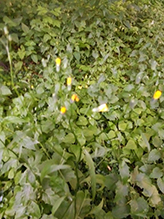common nipplewort
(Lapsana communis)
Conservation • Weed • Wetland • Description • Habitat • Ecology • Use • Distribution • Taxonomy
Description |
Common nipplewort, also called simply nipplewort, is an exotic, weedy, easily recognized, flowering plant. It is native to Europe, western Asia, northern Africa, and the Indian subcontinent. It was introduced in many regions and is now naturalized widely, including in North America. It occurs in the United States in the east from Maine to northern Georgia, west to Minnesota and Arkansas. In the west it occurs in northern Washington, west to Idaho, and south to southern California. Outside of these areas, it has also been reported in most major metropolitan areas except in the Southwest, the Great Basin, and the Great Plains. In regions outside of its native range, common nipplewort is found in disturbed areas, including woodland openings, fields, forest edges, stream banks, roadsides, city alleys, campgrounds, edges of yards, and gardens. It grows under full sun to light shade, in moist to dry, loamy or gravelly soil. Once established, it is difficult to eradicate. It can survive infrequent or irregular mowing, and the seeds remain viable in the soil for up to five years. Common nipplewort is an erect, annual forb that rises on usually a single stem, sometimes a few stems, from shallow, fibrous roots. It can be 6″ to 60″ (15 to 150 cm) tall, but it is usually no more than 32″ (80 cm) in height. The stem is erect, green or often reddish, round, and finely ridged. It is sparsely to moderately covered at first with slender, spreading hairs. The hairs near the tip are often gland-tipped. The stem sometimes becomes almost hairless as it ages. It is unbranched or it has only a few branches below the inflorescence. Both basal and stem leaves are produced. The basal leaves are few and do not form a rosette. The stem leaves are alternate. Basal and lower stem leaves are up to 6″ (15 cm) long and up to 2¾″ (7 cm) wide. They are on long, narrowlywinged leaf stalks (petioles). The leaf blade is inversely egg shaped to inversely lance shaped in outline. It is deeply, pinnately cut into usually three, sometimes more lobes. The terminal lobe is large and egg shaped to broadly triangular. The lateral lobes are much smaller and sharply triangular. The shape resembles a nipple, and this is the source of the common name of this plant. The spaces between the lobes (sinuses) are broadly rounded. The upper and lower surfaces are sparsely to moderately covered with short, white, more or less spreading, non-glandular hairs. The margins are scalloped and wavy. There is a single main vein, several secondary veins extending outward then branching and rejoining before reaching the margin (anastomosing), and a network of tertiary veins. The veins are depressed, and they give the leaf surface a wrinkled appearance. The inflorescence is a branched, open, flat-topped, rounded, egg-shaped, or cylinder-shaped array (panicle) of usually 15 to 25, sometimes many more, flower heads. Each flower head is on a long, slender stalk (peduncle). The peduncle is hairless, and it has no inflorescence leaves (bracts). Beneath each flower head there is a group (calyx) of 4 to 5 bracts (calyculi). Each calyculi is hairless, scale-like, and 1⁄64″ to 1⁄16″ (0.5 to 2.0 mm) long. Surrounding the base of the flower head is a whorl (involucre) of 8 or 10 bracts (phyllaries). The phyllaries are stiff, erect, hairless, linear oblong, and of equal length ⅛″ to ⅜″ (3 to 9 mm) long. Each flower is ½″ (12 mm) in diameter. There are 8 to 15 pale yellow to lemon yellow ray florets and no disk florets. Each ray floret is strap shaped, is ¼″ to ⅜″ (7 to 10 mm) long, and has 5 teeth at the tip. The fruit is a tan to golden brown, ⅛″ to 3 ⁄16″ (3 to 5 mm) long, curved seed capsule (cypsela) with a single seed. The outer cypselae are much longer than the inner ones. Each cypsela is hairless and has about 20 ribs. There is no tuft of hairs (pappus) at the tip. |
Height |
6″ to 60″ (15 to 150 cm) |
Flower Color |
Yellow |
Similar Species |
Habitat |
Moist to dry. Full to partial sun. Disturbed areas, including woodland openings, fields, forest edges, stream banks, roadsides, city alleys, campgrounds, edges of yards, and gardens. Loamy or gravelly soil. |
Ecology |
Flowering |
Junie to September |
Pests and Diseases |
|
Use |
|
Distribution |
||
|
Sources 2, 3, 4, 5, 22, 24, 28, 29, 30. MISIN. 2024. Midwest Invasive Species Information Network. Michigan State University – Department of Entomology. USA. http://www.misin.msu.edu. Accessed 10 September, 2024. |
|
| 9/10/2024 | ||
Nativity |
||
Native to Europe, western Asia, northern Africa, and the Indian subcontinent. Introduced and naturalized. |
||
Occurrence |
||
|
||
Taxonomy |
|
Kingdom |
|
Division |
Tracheophyta (Vascular Plants) |
Subdivision |
Spermatophytina (Seed Plants) |
Class |
|
Order |
Asterales (Sunflowers, Bellflowers, Fanflowers, and Allies) |
Family |
Asteraceae (Sunflowers, Daisies, Asters, and Allies) |
Subfamily |
Cichorioideae (chicories, dandelions, and allies) |
Tribe |
Cichorieae (lettuce, chicory, dandelion, and salsify) |
Subtribe |
Crepidinae (dandelions, hawksbeards, and rattlesnake roots) |
Genus |
Lapsana (nipplewort) |
Subordinate Taxa |
|
Several subspecies have been described in Europe. Only one has been introduced in North America. Where only one subspecies occurs on the continent, most North American sources do not list the subspecies (trinomial) name, just the species (binomial) name. |
|
common nipplewort (Lapsana communis ssp. adenophora) common nipplewort (Lapsana communis ssp. alpina) common nipplewort (Lapsana communis ssp. communis) common nipplewort (Lapsana communis ssp. grandiflora) common nipplewort (Lapsana communis ssp. pisidica) large nipplewort (Lapsana communis ssp. intermedia) |
|
Synonyms |
|
Lapsana cancellata Lapsana cappadocica Lapsana crispa Lapsana glandulosa Lapsana olympica Lapsana pubescens Lapsana sonchifolia Lapsana sylvatica |
|
Common Names |
|
common nipplewort nipplewort |
|
Glossary
Anastomosing
Referring to veins, such as on a plant leaf or a lichen, or lines on an insect wing, that branch and rejoin, forming a network.
Bract
Modified leaf at the base of a flower stalk, flower cluster, or inflorescence.
Calyx
The group of outer floral leaves (sepals) below the petals, occasionally forming a tube. Plural: calyces.
Cypsela
A dry, one-chambered, single-seeded seed capsule, formed from a single carpel, with the seed attached to the membranous outer layer (wall) only by the seed stalk; the wall, formed from the wall of the inferior ovary and also from other tissues derived from the receptacle or hypanthium, does not split open at maturity, but relies on decay or predation to release the contents.
Involucre
A whorl of bracts beneath or surrounding a flower, flower head, or flower cluster.
Peduncle
In angiosperms, the stalk of a single flower or a flower cluster; in club mosses, the stalk of a strobilus or a group of strobili.
Petiole
On plants: The stalk of a leaf blade or a compound leaf that attaches it to the stem. On ants and wasps: The constricted first one or two segments of the rear part of the body.
Phyllary
An individual bract within the involucre of a plant in the Asteraceae family.
Winged leaf stalk
A leaf stalk with a leaf-like or membrane-like extension along both sides.
Visitor Photos |
||
Share your photo of this plant. |
||
This button not working for you? |
||
Luciearl |
||
This has quickly spread throughout a no mow area. Fearing another invasive. Difficult to get a clear photo of the cluster of tiNY flowers on top. |
||
 |
 |
|
 |
||
MinnesotaSeasons.com Photos |
||
|
||
|
||

Slideshows |
|

Visitor Videos |
||
Share your video of this plant. |
||
This button not working for you? |
||
|
Other Videos |
||
Nipplewort aka Lapsana communis |
About
Nov 4, 2020 It's Weed Wednesday! Every Wednesday for several weeks I've been posting a video about some gnarly weed! This will be the last Weed Wednesday this year - but we will start them up again next growing season! This pesky little bugger is called Nipplewort (no, I don't know who came up with that name or why...). Scientific name: Lapsana communis I do have lots of fun ideas for videos over the winter, including reviews on my favorite gardening books and a series on taxonomy and plant families. I'll also throw in a couple videos with Lily just to keep things interesting. Thanks for watching! Subscribe for more gardening tips, tricks and hacks! Have a great winter! See you in the garden! |
Nipplewort (Lapsana Communis) - 2012-06-23 |
About
Jun 25, 2012 Lapsana is a genus of flowering plants in the family Asteraceae, containing a single species, Lapsana communis (Nipplewort). |
Nipplewort Unveiled: A Fascinating Look at a Wildflower with Unique Features and Uses |
About
Jul 18, 2022 or more information about Nipplewort, please visit http://www.wildflowerweb.co.uk/plant/341/nipplewort |
Lapsana communis |
About
Jun 7, 2013 Nipplewort - Three guesses what that name means. Actually I do not know. An annual herb in the Asteraceae family that often grows in clusters. Each plant can be up to 150 cm tall. Several small ray-like yellow flowers will eventually appear. |
Know Your Weeds: Nipplewort |
About
Jun 9, 2013 The name is Nipplewort and it is extraordinarily fecund. No idea really why it has that name as it is not at all nipply as far as I can see. It's botanical name is Lapsana communis and it has little yellow flowers. Rather anassuming and unattractive little yellow flowers. If gardening is your bag then you should definitely visit the intoGardens YouTube channel for more hints, advice, plant profiles and general jollity. |

Visitor Sightings |
||
Report a sighting of this plant. |
||
This button not working for you? |
||
Luciearl |
Location: Lake Shore This has quickly spread throughout a no mow area. Fearing another invasive. Difficult to get a clear photo of the cluster of tiNY flowers on top. |
 |
MinnesotaSeasons.com Sightings |
||
|

|
Created: 9/10/2024 Last Updated: © MinnesotaSeasons.com. All rights reserved. |

